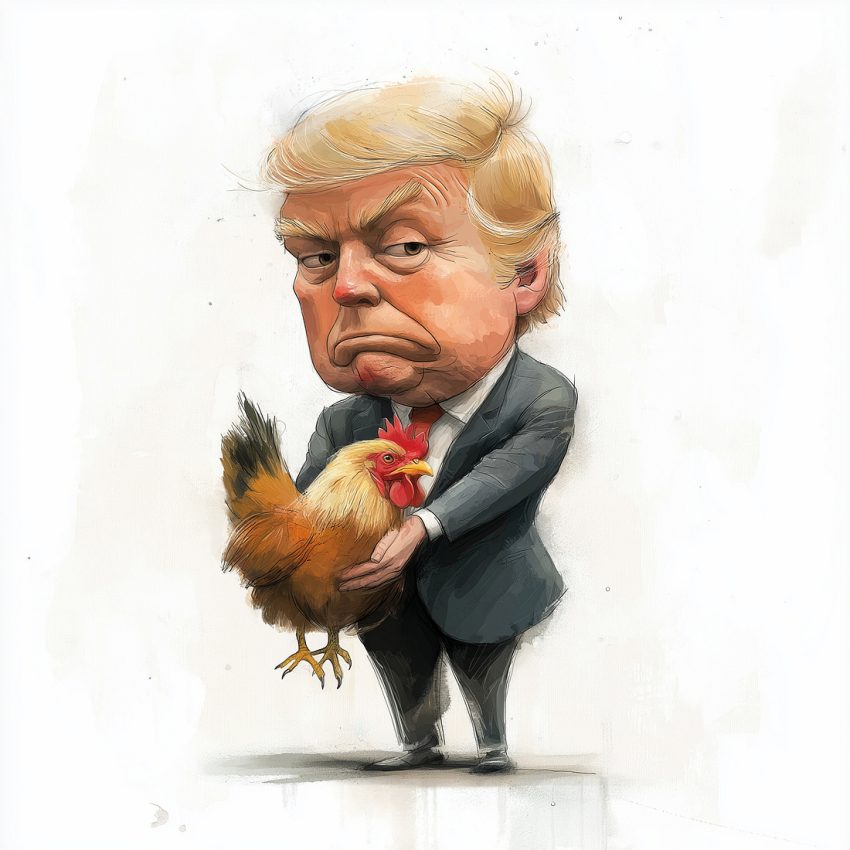 EDITOR’S NOTE: Here’s an installment from Tillamook County’s State Representative Cyrus Javadi’s Substack blog, “A Point of Personal Privilege” Oregon legislator and local dentist. Representing District 32, a focus on practical policies and community well-being. This space offers insights on state issues, reflections on leadership, and stories from the Oregon coast, fostering thoughtful dialogue. Posted on Substack, 4/14/25
EDITOR’S NOTE: Here’s an installment from Tillamook County’s State Representative Cyrus Javadi’s Substack blog, “A Point of Personal Privilege” Oregon legislator and local dentist. Representing District 32, a focus on practical policies and community well-being. This space offers insights on state issues, reflections on leadership, and stories from the Oregon coast, fostering thoughtful dialogue. Posted on Substack, 4/14/25
How global trade tantrums land on Oregon farms, your grocery bill, and the poor guy just trying to export a drumstick.
By Cyrus Javadi, State Representative District 32
There’s an old saying in politics that if you’re explaining, you’re losing. But when it comes to tariffs, if you’re not explaining, you’re probably just yelling. And these days, yelling about tariffs has become a national pastime—right up there with overanalyzing inflation and pretending to understand the Federal Reserve’s cosmic mysteries.
Yes, I realize tariffs aren’t exactly crowd-pleasers. Bring up tariffs mid-drive and watch your spouse nod off like you just turned on NPR at half speed. Still, they’re suddenly headline news again, so even if your eyes glaze over when you hear “import duties,” it’s worth hanging tight. Tariffs can affect everything from the cost of your phone to your cousin’s job at Nike, and the debates swirling around them shape whether your next gadget spikes in price or your neighbor’s factory stays afloat.
I’m not here to convert you into a die-hard tariff lover or a devout tariff hater. Consider this more like a crash course in what tariffs actually are, how they operate, and why you might want to care—even if you’ve never set foot in a port. Because as unsexy as the topic may be, it has real-world repercussions that land squarely in our wallets and workplaces.
A Tax, a Toaster, and a Bad Idea Waiting to Happen
At its core, a tariff is a tax on imported goods. Imagine you’re a foreign-made toaster or a crate of exotic fruit crossing the U.S. border. Customs stops you and hands you a bill for the privilege of entering the country. That extra cost jacks up your price tag, making it easier for a locally produced alternative to compete.
The basic premise is to protect domestic industries and preserve domestic jobs. It’s the economic equivalent of giving the home team a head start. It’s pitched as a way to level the playing field, but more often it levels the whole stadium and sends the fans home broke.
The United States has used tariffs practically since its founding—George Washington signed the first Tariff Act in 1789. Abraham Lincoln was known to be pro-tariff. Then there was the Smoot-Hawley Tariff of 1930, which raised taxes on more than 20,000 products and arguably turned a nasty recession into the full-blown Great Depression.
We Ship Hazelnuts, They Ship TVs, Everybody Complains
When people hear “trade,” they often think of manufacturing jobs migrating to faraway shores. That fear isn’t baseless—plenty of Americans have lost jobs to global competition. But trade itself isn’t some zero-sum cage match. It’s more like a colossal marketplace where everyone’s shopping and everyone’s selling.
Countries (like people) specialize. If Oregon does a killer job growing hazelnuts, it makes sense for them to export hazelnuts rather than, say, try to manufacture discount flip-flops. Meanwhile, Vietnam might produce electronics more efficiently, so we import those. Everybody’s happy—at least in an ideal world.
But the system falls apart if the competition isn’t fair. If foreign governments subsidize industries to undercut our domestic players, or if they impose brutal tariffs on our exports while enjoying carefree entry into our market, that’s not “free” trade at all. In those moments, the home team usually calls for a retaliatory tariff—or five. It’s a little like that kid on the playground who says, “You took my ball, so I’m going to hide your lunch,” and it can escalate just as quickly.
When Poultry Meets Microchips and No One’s Happy
Take Vietnam, for instance. The U.S. recently slapped a 45% tariff on some Vietnamese imports because Vietnam enforces tariffs on certain U.S. products, notably chicken and semiconductor components. The logic from Washington is: “If you’re going to tax our poultry, we’re going to tax your microwaves.”
And that’s how these things often go—a tit-for-tat that can spiral into a full-blown trade war if cooler heads don’t prevail. The irony is that American chicken is one of those few products we genuinely dominate without needing huge subsidies. We just raise and process poultry with astonishing efficiency (not exactly the most glamorous claim to fame, but it’s ours). So when other countries smack tariffs on it, our response can be…decidedly unamused.
Tariffs Don’t Stop at the Coastline
You might be asking, “What’s all this got to do with Oregon?” Well, the Port of Portland is a key shipping hub for everything from agricultural goods to advanced microchips. If tariffs start piling up on either side of a trade dispute, Oregon producers might find themselves priced out of foreign markets—or short on critical parts from abroad.
Big corporations can sometimes shuffle supply chains around, but smaller farmers or niche manufacturers often aren’t so lucky. If you’re used to exporting half your crop to Japan and suddenly it’s slapped with a giant tariff, you’ve got a warehouse full of produce and a big headache. Multiply that scenario by every orchard, workshop, and shipping center across the country, and you start seeing why tariff policy ends up on the evening news instead of just the back pages of The Economist.
A Little Bit of Fair, a Whole Lot of Fallout
Let’s be clear: tariffs aren’t inherently evil. Think of them like antibiotics: necessary for some infections, destructive if you overuse them. Sometimes, a carefully calibrated tariff can stop abusive trade practices (like “dumping,” where foreign producers sell below cost to corner the market). In that sense, tariffs can be a legitimate defensive tool.
The key is moderation and precision. If another country is indeed cheating—racking up unfair advantages, ignoring environmental standards, or running sweatshop-like labor conditions—maybe a targeted tariff can help even the playing field. But slapping a tariff on everything from microwaves to cat litter just because we’re in a bad mood? That’s like using a jackhammer when a simple wrench would do.
First Comes the Chicken Tax, Then the Layoffs
So let’s say a new tariff goes into effect. What happens next? At first, the price hikes show up quietly—at the hardware store, the grocery checkout, or on that irrigation equipment a farmer in Yamhill just ordered. It might not feel catastrophic, but the costs add up, especially when multiple tariffs start stacking like firewood before winter.
In the short term, domestic manufacturers can catch a break. With foreign competition priced out, Oregon producers might see a bump in orders, maybe even hire a few more hands. For a moment, it looks like tariffs are working—propping up jobs, boosting output, restoring a little swagger to the local economy. But that’s usually the easy part.
Then comes the pushback. Retaliation is as predictable as fog in Astoria. Countries we export to slap their own tariffs on Oregon goods—hazelnuts, blueberries, tech components—and suddenly our producers are priced out of key markets. Meanwhile, businesses start hunting for new suppliers outside the tariff zone. That kind of scramble sounds agile, until it drives up costs and forces layoffs.
Stick with tariffs long enough, and trade routes begin to shift permanently. Countries bypass us, strike deals elsewhere, and build new pipelines that don’t include Oregon crops or Oregon-made tools. And instead of modernizing, some of the industries we were trying to protect just hunker down behind the tariff wall, delaying innovation while enjoying a little too much comfort.
Eventually, regular folks feel the squeeze. Prices creep up, product variety shrinks, and no one quite remembers how we got here. That’s why broad, long-running tariffs make economists nervous—they often cost more than they fix, especially when there’s no clear plan for how to end them.
When D.C. Swings the Hammer, Salem Grabs the Broom
Sure, tariffs are federal turf, but the fallout lands squarely in Oregon’s lap. When national trade policy drives up costs or slams the door on exports, it’s state lawmakers who hear the panic first—from farmers, shippers, and manufacturers trying to keep the lights on.
In the short term, the Legislature can shine a spotlight. Public hearings, pressure on our congressional delegation, even temporary tax credits or emergency grants for small exporters caught in the crossfire—these are ways to show we’re not just a passive bystander in someone else’s trade war.
Longer term, we can build resilience. That means investing in ports, workforce retraining, and local supply chains so we’re not knocked flat every time D.C. swings a tariff hammer. We may not write trade deals, but we can make Oregon a place the global economy needs—and can’t afford to bypass.
It’s not flashy, but it’s smart. And in the end, that’s what state policy should be: practical, responsive, and focused on the home front, even when the fight starts somewhere else.
The Grocery Bill Is Trying to Tell You Something
If you ever find yourself at a social gathering and the conversation drifts toward import taxes (hey, it could happen), try to steer it beyond the usual “Tariffs: good or bad?” debate. Think about specific industries, the roles Congress and state legislatures play, and the ripple effects on everyday products. Tariffs may not be as riveting as your favorite Netflix show, but they sure do have a knack for messing with your grocery bill and job market.
In the end, tariffs are tools, not dogma. They can fix a trade imbalance or spark a bigger fight, depending on how—and why—they’re used. So the next time your senator or representative starts talking tariffs, remember: the question isn’t just who we’re taxing, but whether we’re building a foundation for long-term growth or simply reaching for the nearest hammer when a gentle wrench would have done the trick. And if all else fails, there’s always chicken to export.


